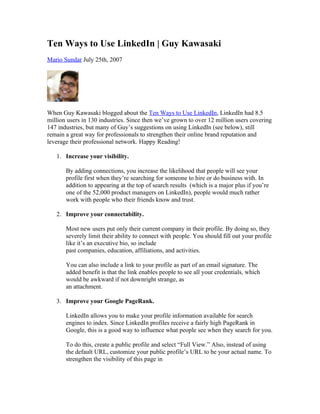
Ten Ways To Use Linked In by Guy Kawasaki
- 1. Ten Ways to Use LinkedIn | Guy Kawasaki Mario Sundar July 25th, 2007 When Guy Kawasaki blogged about the Ten Ways to Use LinkedIn, LinkedIn had 8.5 million users in 130 industries. Since then we’ve grown to over 12 million users covering 147 industries, but many of Guy’s suggestions on using LinkedIn (see below), still remain a great way for professionals to strengthen their online brand reputation and leverage their professional network. Happy Reading! 1. Increase your visibility. By adding connections, you increase the likelihood that people will see your profile first when they’re searching for someone to hire or do business with. In addition to appearing at the top of search results (which is a major plus if you’re one of the 52,000 product managers on LinkedIn), people would much rather work with people who their friends know and trust. 2. Improve your connectability. Most new users put only their current company in their profile. By doing so, they severely limit their ability to connect with people. You should fill out your profile like it’s an executive bio, so include past companies, education, affiliations, and activities. You can also include a link to your profile as part of an email signature. The added benefit is that the link enables people to see all your credentials, which would be awkward if not downright strange, as an attachment. 3. Improve your Google PageRank. LinkedIn allows you to make your profile information available for search engines to index. Since LinkedIn profiles receive a fairly high PageRank in Google, this is a good way to influence what people see when they search for you. To do this, create a public profile and select “Full View.” Also, instead of using the default URL, customize your public profile’s URL to be your actual name. To strengthen the visibility of this page in
- 2. search engines, use this link in various places on the web> For example, when you comment in a blog, include a link to your profile in your signature. 4. Enhance your search engine results. In addition to your name, you can also promote your blog or website to search engines like Google and Yahoo! Your LinkedIn profile allows you to publicize websites. There are a few pre-selected categories like “My Website,” “My Company,” etc. If you select “Other” you can modify the name of the link. If you’re linking to your personal blog, include your name or descriptive terms in the link, and voila! instant search-engine optimization for your site. To make this work, be sure your public profile setting is set to “Full View.” 5. Perform blind, “reverse,” and company reference checks. LinkedIn’s reference check tool to input a company name and the years the person worked at the company to search for references. Your search will find the people who worked at the company during the same time period. Since references provided by a candidate will generally be glowing, this is a good way to get more balanced data. Companies will typically check your references before hiring you, but have you ever thought of checking your prospective manager’s references? Most interviewees don’t have the audacity to ask a potential boss for references, but with LinkedIn you have a way to scope her out. You can also check up on the company itself by finding the person who used to have the job that you’re interviewing for. Do this by searching for job title and company, but be sure to uncheck “Current titles only.” By contacting people who used to hold the position, you can get the inside scoop on the job, manager and growth potential. By the way, if using LinkedIn in these ways becomes a common practice, we’re apt to see more truthful resumes. There’s nothing more amusing than to find out that the candidate who claims to have caused some huge success was a total bozo who was just along for the ride. 6. Increase the relevancy of your job search. Use LinkedIn’s advanced search to find people with educational and work experience like yours to see where they work. For example, a programmer would use search keywords such as “Ruby on Rails,” “C++,” “Python,” “Java,” and “evangelist” to find out where other programmers with these skills work.
- 3. 7. Make your interview go smoother. You can use LinkedIn to find the people that you’re meeting. Knowing that you went to the same school, plays hockey, or shares acquaintances is a lot better than an awkward silence after, “I’m doing fine, thank you.” 8. Gauge the health of a company. Perform an advanced search for company name and uncheck the “Current Companies Only” box. This will enable you to scrutinize the rate of turnover and whether key people are abandoning ship. Former employees usually give more candid opinions about a company’s prospects than someone who’s still on board. 9. Gauge the health of an industry. If you’re thinking of investing or working in a sector, use LinkedIn to find people who worked for competitors—or even better, companies who failed. For example, suppose you wanted to build a next generation online pet store, you’d probably learn a lot from speaking with former Pets.com or WebVan employees. 10. Track startups. You can see people in your network who are initiating new startups by doing an advanced search for a range of keywords such as “stealth” or “new startup.” Apply the “Sort By” filter to “Degrees away from you” in order to see the people closest to you first. [Republished from: Ten Ways to Use LinkedIn via "How to Change the World" -- Guy Kawasaki's blog]